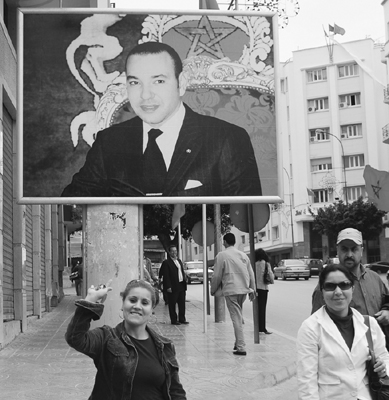
Artists, writers, and musicians have always loved Tangier. Delacroix and Matisse were drawn by its evocative light. The Beat generation, led by William S. Burroughs and Jack Kerouac, sought the city’s multicultural, otherworldly feel. Paul Bowles found his sheltering sky here. From the 1920s through the 1950s, Tangier was an “international city,” too strategic to give to any one nation, and jointly governed by as many as nine different powers, including France, Spain, Britain, Italy, Belgium, the Netherlands...and Morocco. The city was a tax-free zone (since there was no single authority to collect taxes), which created a booming free-for-all atmosphere, attracting playboy millionaires, bon vivants, globe-trotting scoundrels, con artists, and expat romantics. Tangier enjoyed a cosmopolitan golden age that, in many ways, shaped the city visitors see today.
Tangier is always defying expectations. Ruled by Spain in the 19th century and France in the 20th, it’s a rare place where signs are in three languages...and English doesn’t make the cut. In this Muslim city, you’ll find a synagogue, Catholic and Anglican churches, and the town’s largest mosque in close proximity.
Because of its “international zone” status, Morocco’s previous king effectively disowned the city, denying it national funds for improvements. Over time, neglected Tangier became the armpit of Morocco. But when the new king—Mohammed VI—was crowned in 1999, the first city he visited was Tangier. His vision is to restore Tangier to its former glory. Prodding his countrymen with the slogan “Morocco is moving,” he’s nudging the country into the future.
Thanks to King Mohammed VI, Tangier (with a population of 700,000 and growing quickly) is experiencing a rebirth. While the city has a long way to go, restorations are taking place on a grand scale: The beach has been painstakingly cleaned, pedestrian promenades are popping up, and gardens bloom with lush new greenery. A brand-new futuristic soccer stadium opened in 2011, and the city-center port is being converted into a huge, slick leisure-craft complex that will handle cruise megaships, yachts, and ferries from Tarifa.

I’m uplifted by the new Tangier—it’s affluent and modern without having abandoned its roots and embraced Western values. Many visitors are impressed by the warmth of the Moroccan people. Notice how they touch their right hand to their heart after shaking hands or saying, “thank you”—a kind gesture meant to emphasize sincerity. (In Islam, the right hand is holy, while the left hand is evil. Moroccans who eat with their hands—as many civilized people do in this part of the world—always eat with their right hand; the left hand is for washing.)
A visit to Morocco—so close to Europe, yet embracing the Arabic language and script and Muslim faith—lets a Westerner marinated in anti-Muslim propaganda see what Islam aspires to be and can be...and realize it is not a threat.
If you’re not on a package tour, pre-arrange for a guide to meet you at the ferry dock (see “Guides,” later), hire a guide upon arrival, or head on your own to the big square called the Grand Socco to get oriented (you can walk or catch a Petit Taxi from the port to the Grand Socco). Get your bearings with my Grand Socco spin-tour, then delve into the old town (the lower Medina, with the Petit Socco, market, and American Legation Museum; and the upper Medina’s Kasbah, with its museum and residential lanes). With more time, take a taxi to sightsee along the beach and then along Avenue Mohammed VI, through the urban new town, and back to the port. You’ll rarely see other tourists outside the tour-group circuit.
After Dark: Nighttime is great in Tangier. If you’re spending the night, don’t relax in a fancy hotel restaurant. Get out and about in the old town after dark. It’s an entirely different experience and a highlight of any visit. (But remember, this isn’t night-owl Spain—things die down by around 22:00.)
Like almost every city in Morocco, Tangier is split in two: old and new. From the ferry dock you’ll see the old town (Medina)—encircled by its medieval wall—on your right, behind Hotel Continental. The old town has the markets, the Kasbah (with its palace and the mosque of the Kasbah—marked by the higher of the two minarets you see), cheap hotels, characteristic guest houses, homes both decrepit and recently renovated, and 2,000 wannabe guides. The twisty, hilly streets of the old town are caged within a wall accessible by keyhole gates. The larger minaret (on the left) belongs to the modern Mohammed V mosque—the biggest one in town.

The new town, with the TI and modern international-style hotels, sprawls past the industrial port zone to your left. The big square, Grand Socco, is the hinge between the old and new parts of town.
Note that while tourists (and this guidebook) refer to the twisty old town as “the Medina,” locals consider both the old and new parts of the city center to be medinas.
Tangier is the fifth-largest city in Morocco, and many visitors assume they’ll get lost here. While the city could use more street signs, it’s laid out simply—although once you enter the mazelike Medina, all bets are off. Nothing listed under “Sights in Tangier” is more than a 20-minute walk from the port. Petit Taxis (described later, under “Getting Around Tangier”) are a remarkably cheap godsend for the hot and tired tourist. Use them liberally.
Because so many different colonial powers have had a finger in this city, it goes by many names: In English, it’s Tangier (or Tangiers); in French, Tanger (tahn-zhay); in Arabic, it’s Tanja (TAHN-zhah); in Spanish, Tánger (TAHN-hair, with a guttural h); and so on. Unless you speak Arabic, French is the handiest second language, followed by Spanish and (finally) English.
The TI, about a 15-minute gradual uphill walk from the Grand Socco, is not particularly helpful (English is in short supply, but a little French goes a long way). But at least you can pick up a free town brochure—in French only—with a town map (Mon-Fri 8:30-16:30, closed Sat-Sun, in new town at Boulevard Pasteur 29, tel. 0539-94-80-50). There’s also a TI desk at the Tangier MED Port, and there may be one at the city-center Tangier Medina Port in the future.
The urban area around the Tangier TI has a few interesting features. The yellow building across the small street from the TI (toward the Grand Socco) is a synagogue. A block farther is the beautiful Place de Faro terrace, with its cannons and views back to Spain. (Nicknamed “Terrace of the Lazy Ones,” this momentum-killing spot is usually lined with men relaxing and enjoying the views.) Beyond that, Rue de la Liberté leads directly into the Grand Socco square, the hub of old Tangier.
If you’re taking a tour, just follow the leader. If you’re on your own, you’ll want to head for the Grand Socco to get oriented. You can either take a taxi (cheap) or walk (about 10 gently uphill minutes through the colorful but confusing lanes of the Medina). Note that the entire port area is slated for an extensive reconstruction in the coming years, so you may find some changes from the way things are described here.
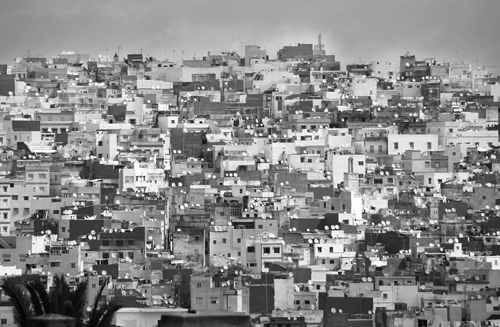
A small blue Petit Taxi is your easiest way to get from the port into town (described later, under “Getting Around Tangier”); unfortunately, prices are not regulated from the port. An honest cabbie will charge you 20-30 dh (about $3) for a ride from the ferry into town; less scrupulous drivers will try to charge closer to 100 dh. Set your price before hopping in.
To walk into town, head out through the port entrance checkpoint (by the mosque) and bear left at the stubby wall, passing the big bus parking lot and the white Hotel Continental on your right-hand side. After a few minutes, at the end of the bus lot, look for a mosque’s white minaret with green tile high on the hill, and head toward it by going up the street just beyond the long, high white wall (behind the buses). Go through the yellow gateway (Bab Dar Dbagh) marked 1921 and 1339. Bear right/uphill at the T-intersection, then turn left/uphill on Rue de la Marine. You’ll pass a school on the right, then the mosque with the green minaret on your left. Continue straight up to the café-lined Petit Socco square, then continue to the top of the street and turn left before the white gate to enter the Grand Socco. Leave mental breadcrumbs as you walk, so you can find your way back to your boat. If all else fails, head downhill.
The Tangier Airport (Aeroport Ibn Battouta, airport code: TNG) is very new-feeling, slick, and well-organized, with ATMs, cafés, and other amenities. Iberia, Royal Air Maroc, easyJet, and Ryanair fly from here to Madrid (easyJet also has a route to Paris). Jet4you, another low-cost airline, is based in Casablanca, but offers flights from Tangier to Barcelona and Brussels (www.jet4you.com). To get into downtown Tangier, taxis should run you about 150 dh and take 30-45 minutes.
There are two types of taxis: Avoid the big, beige Mercedes “Grand Taxis,” which are the most aggressive and don’t use their meters (they’re designed for longer trips outside of the city center, but have been known to take tourists for a ride in town...in more ways than one). Look instead for Petit Taxis—blue with a yellow stripe (they fit 2-3 people). These generally use their meters, are very cheap, and only circulate within the city. However, at the port, Petit Taxis are allowed to charge whatever you’ll pay without using the meter, so it’s essential to agree on a price up front (see “Arrival in Tangier,” earlier).
Be aware that Tangier taxis sometimes “double up”—if you’re headed somewhere, the driver may pick up someone else who’s going in the same direction. However, in this case you don’t get to split the fare—each of you pays full price (even though sometimes the other passenger’s route takes you a bit out of your way).
Money: The exchange rate is 8 dh = about $1; 11 dh = about €1. While most businesses happily take euros or dollars, it’s classier to use the local currency—and you’ll save money. If you’re on a tour, they’ll rip you off anyway, so just stick with euros. If you’re on your own, it’s fun to get a pocket full of dirhams.
A few ATMs are around the Grand Socco (look for one just to the left of the archway entrance into the Medina); more are opposite the TI along Boulevard Pasteur. ATMs work as you expect them to. Banks and ATMs have uniform rates.
Exchange desks are quick, easy, and fair. (Just understand the buy-and-sell rates—they should be within 10 percent of one another with no other fee. If you change €50 into dirhams and immediately change the dirhams back, you should have about €45.) Look for the official Bureaux de Change offices, where you’ll get better rates than at the banks. There are some on Boulevard Pasteur, and a handful between the Grand and Petit Soccos. The official change offices all offer the same rates, so there’s no need to shop around.
Convert your dirhams back to euros before catching the ferry—it’s cheap and easy to do here (change desks at the port keep long hours), but very difficult once you’re back in Spain.
Phoning: To call Tangier from Spain, dial 00 (Europe’s international access code), 212 (Morocco’s country code), then the local number (dropping the initial zero). To dial Tangier from elsewhere in Morocco, dial the local number in full (keeping the initial zero).
Keeping Your Bearings: Tangier’s maps and street signs are frustrating. I ask in French for the landmark: Où est...? (“Where is...?,” pronounced oo ay, as in “oo ay Medina?” or “oo ay Kasbah?”). It can be fun to meet people this way. However, most people who offer to help you (especially those who approach you) are angling for a tip—young and old, locals see dollar signs when a traveler approaches. To avoid getting unwanted company, ask for directions only from people who can’t leave what they’re doing (such as the only clerk in a shop) or from women who aren’t near men. There are fewer hustlers in the new (but less interesting) part of town. Be aware that most people don’t know the names of the smaller streets (which don’t usually have signs), and tend to navigate by landmarks. In case you get the wrong directions, ask three times and go with the consensus. If there’s no consensus, it’s time to hop into a Petit Taxi.
Mosques: Tangier’s mosques (and virtually all of Morocco’s) are closed to non-Muslim visitors.
If you’re on your own, you’ll be to street guides what a horse’s tail is to flies...all day long. Seriously—it can be exhausting to constantly deflect come-ons from anyone who sees you open a guidebook. In order to have your own translator, and a shield from less scrupulous touts who hit up tourists constantly throughout the old town, I recommend hiring a guide. Stress your interest in the people and culture rather than shopping. Guides, hoping to get a huge commission from your purchases, can cleverly turn your Tangier day into the Moroccan equivalent of the Shopping Channel. Truth be told, some of these guides would work for free, considering all the money they make on commissions when you buy stuff.
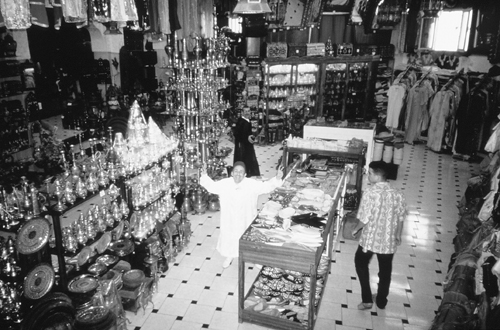
I’ve worked with a variety of guides who speak great English, are easy to get along with, will meet you at the ferry dock, and charge fixed rates. They’ve promised me they won’t make you do any more shopping than you want to—so be very clear about your interests. If one of these guides is busy (or takes a long time responding to your email), try the others. Any of these guides will make your Tangier experience more enjoyable for a negligible cost. They can also book your ferry tickets for the same cost as booking direct: They’ll give you a reference number to give at the ticket office in Tarifa, then you’ll pay them for the tickets when you meet in Tangier. While each has their own specific itineraries, the two basic options are more or less the same: a half-day walking tour around the Medina and Kasbah (generally 3-5 hours); or a full-day “grand tour” that includes the walk around town as well as a minibus ride to outlying viewpoints—the Caves of Hercules and Cape Spartel (7-8 hours, generally also includes lunch at your expense in a restaurant the guide suggests). Prices are fairly standard from guide to guide. If you’re very pleased with your guide, he’ll appreciate a tip.
Aziz Begdouri, who enjoys teaching about Moroccan society and culture, has been a big help to me with my guidebook-writing and TV production in Tangier (half-day walking tour-€15/person, groups limited to 4-5 people; 8-hour grand tour-€35/person; mobile 06-6163-9332, from Spain dial 00-212-6-6163-9332, aziz tour@hotmail.com).
Salah Abdi grew up in the Medina and has devoted the past 30 years to showing tourists around his hometown. He is a delight, full of historical knowledge and American sports trivia, and his tours give customers an intimate insider experience (half-day walking tour-€15/person, groups limited to 4-5 people; full-day grand tour-€35/person for up to 10 people; call to book at least a day in advance, mobile 06-4943-4911, from Spain dial 00-212-6-4943-4911).
If Aziz Begdouri or Salah are busy, consider one of the following youthful go-getters who are a bit lighter on information, but enjoyable to spend time with and dedicated to making visitors comfortable: Aziz Benami (half-day walking tour-€15/person; full-day minibus and walking tour-€35/person, mobile 06-6126-3335, from Spain dial 00-212-6-6126-3335, www.tangierprivateguide.com, info@tangierprivateguide.com) and Abdellatif (“Latif”) Chebaa (half-day walking tour-€15/person, grand tour-€35/person, mobile 06-6107-2014, from Spain dial 00-212-6-6107-2014, visittangier@gmail.com).
Other Options: If you don’t want to plan too far ahead, and any guide will do, you can book a “VIP tour” through the ferry company in Tarifa for approximately the same prices listed above. I’ve also had good luck with the private guides who meet the boat. If you’re a decent judge of character, try interviewing guides when you get off the ferry to find one you click with, then check for an official license and negotiate a good price. These hardworking, English-speaking guides offer their services for the day for €15.
This big, bustling square is a transportation hub, market, popular meeting point, and the fulcrum between the new town and the old town (Medina). A few years ago, it was a pedestrian nightmare and a perpetual traffic jam. But now, like much of Tangier, it’s on the rise. Many of the sights mentioned in this spin-tour are described in more detail later in this chapter.
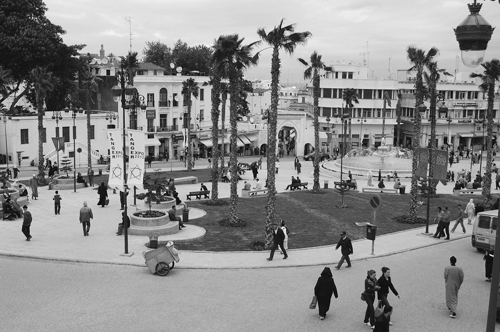
 Self-Guided Spin Tour: The Grand Socco is a good place to get oriented to the heart of Tangier. Stand on
the square between the fountain and the mosque (the long building with arches and
the tall tower). We’ll do a slow clockwise spin.
Self-Guided Spin Tour: The Grand Socco is a good place to get oriented to the heart of Tangier. Stand on
the square between the fountain and the mosque (the long building with arches and
the tall tower). We’ll do a slow clockwise spin.
Start by facing the mosque—newly remodeled with a long arcade of keyhole arches, and with a colorfully tiled minaret. Morocco is a decidedly Muslim nation, though its take on Islam is progressive, likely owing to the country’s crossroads history. For example, women are relatively free to dress as they like. Five times a day, you’ll hear the call to prayer echo across the rooftops of Tangier, from minarets like this one. Unlike many Muslim countries, Morocco doesn’t allow non-Muslims to enter its mosques (with the exception of its biggest and most famous one, in Casablanca). This custom may have originated decades ago, when occupying French foreign legion troops spent the night in a mosque, entertaining themselves with wine and women. Following this embarrassing desecration, it was the French government—not the Moroccans—who instituted the ban that persists today.

Locals say that in this very cosmopolitan city, anytime you see a mosque, you’ll find a church nearby. Sure enough, peeking up behind the mosque, you can barely make out the white, crenellated top of the Anglican Church’s tower (or at least the English flag above it—a red cross on a white field). A fascinating architectural hybrid of Muslim and Christian architecture, this house of worship is well worth a visit.
Also behind the mosque, you can see parts of a sprawling market. (This features mostly modern goods; the far more colorful produce, meat, and fish market is across the square.) Those market stalls used to fill the square you’re standing in; traditionally the Grand Socco was Tangier’s hub for visiting merchants. The gates of town would be locked each evening, and vendors who did not arrive in time spent the night in this area. (Nearby were many caravanserai—old-fashioned inns.) But a few years ago, this square was dramatically renovated by the visionary king, Mohammed VI, and given a new name: “April 9th Square,” commemorating the date in 1947 when an earlier king, Mohammed V, appealed to his French overlords to grant his country its independence. (France eventually complied, peacefully, in 1956.) In just the last few years, Mohammed VI tamed the traffic, added the fountain you’re standing next to (there was never a fountain here before), and turned this into a delightfully people-friendly space.
Spin a few more degrees to the right, where you’ll see the crenellated gateway marked Tribunal de Commerce—the entrance to the Mendoubia Gardens, a pleasant park with a gigantic tree and a quirky history that reflects the epic story of Tangier (particularly from the 1920s to the 1950s, when multiple foreign powers shared control of this city). At the top of the garden gateway, notice the Moroccan flag: a green five-pointed star on a red field. The five points of the star represent the five pillars of Islam; green is the color of peace, and red represents the struggles of hard-fought Moroccan history.
Spinning farther right, you’ll see the keyhole arch marking the entrance to the Medina. (If you need cash, notice the exchange booths and ATM just to the left of this gateway.) To reach the heart of the Medina—the Petit Socco (the café-lined little brother of the square you’re on now)—go through this arch and take the first right.
In front of the arch, you’ll likely see day laborers looking for work. Each one stands next to a symbol of the kind of work he specializes in: a bucket of paintbrushes for a painter, a coil of wiring for an electrician, and a loop of hose for a plumber.
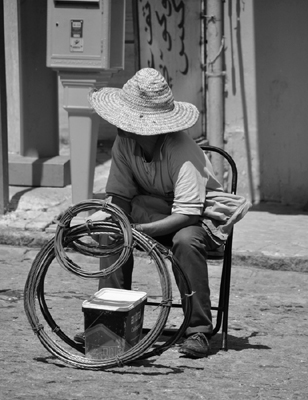
Speaking of people looking for work, how many locals have offered to show you around (“Hey! What you looking for? I help you!”) since you’ve been standing here, holding this guidebook? Get used to it. While irritating, it’s understandable. To these very poor people, you’re impossibly rich—your pocket change is at least a good day’s wage. If someone pesters you, you can simply ignore them, or say “Lah shokran” (No, thank you). But be warned: The moment you engage them, you’ve just prolonged the sales pitch.
Back to our spin-tour: To the right of the main arch, and just before the row of green rooftops, is the low-profile entrance to the market (souk). A barrage on all the senses, this is a fascinating place to explore. The row of green rooftops leads toward Rue de la Plage, with more market action.
Continue spinning another quarter-turn to the tall, white building at the top of the square labeled Cinema Rif. This historic movie house still plays films (in Arabic and French). The street to the left of the cinema takes you to Rue de la Liberté, which eventually leads through the modern town to the TI (about a 15-minute walk). Just to the right of the cinema, notice the yellow terrace, which offers the best view over the Grand Socco (just go up the staircase). It’s also part of a café, where you can order a Moroccan tea (green tea, fresh mint, and lots of sugar), enjoy the view over the square, and plot your next move.
These sights are near the Grand Socco, but still outside the Medina (old town).
▲Anglican Church—St. Andrew’s Anglican Church, tucked behind a showpiece mosque, embodies Tangier’s mingling of Muslim and Christian tradition. The land on which the church sits was a gift from the sultan to the British community in 1881, during Queen Victoria’s era. Shortly thereafter, this church was built. Although fully Christian, the church is designed in the style of a Muslim mosque. The Lord’s Prayer rings the arch in Arabic, as verses of the Quran would in a mosque. Knock on the door—Ali or his son Yassin will greet you and give you a “thank you very much” tour. The garden surrounding the church is a tranquil, park-like cemetery.
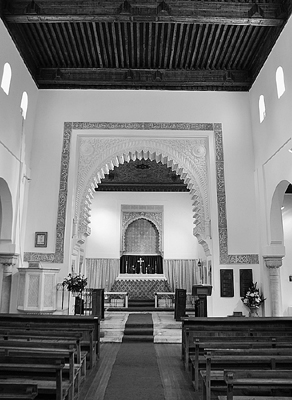
Cost and Hours: A tip of about 20 dh is appreciated; daily 9:00-18:00 except closed during Sunday services.
Mendoubia Gardens—This pleasant park, through the castle-like archway off of the Grand Socco, is a favorite place for locals to hang out, but also has a surprising history. Walk through the gateway to see the trunk of a gigantic banyan tree, which, according to local legend, dates from the 12th century. Notice how the extra supportive roots have grown from the branches down to the ground. The large building to the left—today the business courthouse (Tribunal de Commerce)—was built to house the representative of the Moroccan king, back in the early 20th century when Tangier was ruled as a protectorate of various European powers and needed an ambassador of sorts to keep an eye out for Moroccan interests. The smaller house on the right (behind the giant tree) is currently the marriage courthouse (used exclusively for getting married or divorced), but it was once the headquarters of the German delegation in Tangier. France originally kept Germany out of the protectorate arrangement by giving them the Congo. But in 1941, when Germany was on the rise in Europe and allied with Spain’s Franco, it joined the mix of ruling powers in Tangier. Although Germans were only here for a short time (until mid-1942), they had a small cemetery in what’s now the big park in front of you. If you go up the stairs and around the blocky Arabic monument, at the bases of the trees beyond it you’ll find headstones of German graves...an odd footnote in the very complex history of this intriguing city.

Tangier’s Medina is its convoluted old town—a twisty mess of narrow stepped lanes, dead-end alleys, and lots of local life spilling out into the streets. It’s divided roughly into two parts: the lower Medina, with the Petit Socco, market, American Legation, and bustling street life; and, at the top, the more tranquil Kasbah.

A maze of winding lanes and tiny alleys weave through the old-town market area. Write down the name of the gate you came in, so you can enjoy being lost—temporarily.
Petit Socco—This little square, also called Souk Dahel (“Inner Market”), is the center of the lower Medina. Lined with tea shops and cafés, it has a romantic quality that has long made it a people magnet. In the 1920s, it was the meeting point for Tangier’s wealthy and influential elite; by the 1950s and ’60s, it drew Jack Kerouac and his counterculture buddies. Nursing a coffee or a mint tea here, it’s easy to pretend you’re a Beat Generation rebel, dropping out from Western society and delving deeply into an exotic, faraway culture. More recently, filmmakers have been drawn here. Scenes from both The Bourne Ultimatum and Inception were filmed on the streets between the Grand and Petit Soccos.
The Petit Socco is ideal for some casual people-watching over a drink. You can go to one of the more traditional cafés, but Café Central—with the modern awning—is the most accessible, and therefore the most commercialized and touristy (7-12-dh coffee drinks, 20-45-dh meals, daily 6:00-24:00).
▲▲ Market (Souk)—The Medina’s market, just off the Grand Socco, is a highlight. Wander past piles of fruit, veggies, and olives, countless varieties of bread, and fresh goat cheese wrapped in palm leaves. Phew! You’ll find everything but pork.
Entering the market through the door from the Grand Socco, turn right to find butchers, a cornucopia of produce (almost all of it from Morocco), more butchers, piles of olives, and yet more butchers. The chickens are plucked and hung to show they have been killed according to Islamic guidelines (Halal): Animals are slaughtered with a sharp knife in the name of Allah, head to Mecca, and drained of their blood. The far aisle (parallel and to the left of where you’re walking) has more innards and is a little harder to stomach.
You’ll see women vendors wearing straw hats decorated with ribbons, and often also striped skirts, scattered around the market; these are Berbers, who ride donkeys to the city from the nearby Rif Mountains, mostly on Tuesdays and Thursdays. (Before taking photos of these women, or any people you see here, it’s polite to ask permission.)
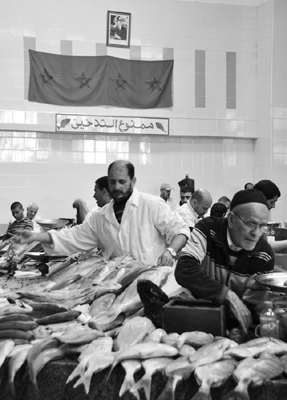
Eventually you’ll emerge into the large white market of fish-sellers; with the day’s catch from both the Mediterranean and the Atlantic, this is like a textbook of marine life. The door at the far end of the fish market pops you out on the Rue Salah El-dine Al Ayoubi; a right turn takes you back to the Grand Socco, but a left turn leads to the (figurative and literal) low end of the market—a world of very rustic market stalls under a corrugated plastic roof. While just a block from the main market, this is a world apart, and not to everyone’s taste. Here you’ll find cheap produce, junk shops, electronics (such as recordable CDs and old remote controls), old ladies sorting bundles of herbs from crinkled plastic bags, and far less sanitary-looking butchers than the ones inside the main market hall (if that’s possible). Peer down the alley filled with a twitching poultry market, which encourages vegetarianism.
The upper part of the market (toward the Medina and Petit Socco) has a few food stands, but more non-perishable items, such as clothing, cleaning supplies, toiletries, and prepared foods. Scattered around this part of the market are spice and herb stalls (usually marked hérboriste), offering a fragrant antidote to the meat stalls. In addition to cooking spices, these sell homegrown Berber cures for ailments. Pots hold a dark-green gelatinous goo—a kind of natural soap.
If you’re looking for souvenirs, you won’t have to find them... they’ll find you, in the form of aggressive salesmen who approach you on the street and push their conga drums, T-shirts, and other trinkets in your face. Most of the market itself is more focused on locals, but the Medina streets just above the market are loaded with souvenir shops. Aside from the predictable trinkets, the big-ticket items here are tilework (such as vases) and carpets. You’ll notice many shops have tiles and other, smaller souvenirs on the ground floor, and carpet salesrooms upstairs.
▲▲▲Exploring the Medina—Appealing as the market is, one of the most evocative Tangier experiences is to simply lose yourself in the lanes of the Medina. A first-time visitor cannot stay oriented—so don’t even try. I just wander, knowing that uphill will eventually get me to the Kasbah and downhill will eventually lead me to the port. Expect to get a little lost...going around in circles is part of the fun. Pop in to see artisans working in their shops: mosaic tile-makers, thread spinners, tailors. While shops are on the ground level, the family usually lives upstairs. Doors indicate how many families live in the homes behind them: one row of decoration for one, another parallel row for two.
Many people can’t afford private ovens, phones, or running water, so there are economical communal options: phone desks (called teleboutiques), baths, and bakeries. If you smell the aroma of baking bread, look for a hole-in-the-wall bakery, where locals drop off their ready-to-cook dough (as well as meat, fish, or nuts to roast). You’ll also stumble upon communal taps, with water provided by the government, where people come to wash. Cubby-hole rooms are filled with kids playing video games on old TVs—they can’t afford their own at home, so they come here instead.
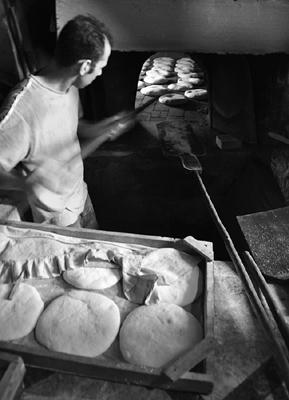
Go on a photo safari for ornate “keyhole” doors, many of which lead to neighborhood mosques. Green doors are the color of Islam and symbolize peace. The ring-shaped door knockers double as a place to hitch a donkey.
As you explore, notice that some parts of the Medina seem starkly different, with fancy wrought-iron balconies. This is the approximately 20 percent of the town that was built and controlled by Spaniards and Portuguese living here (with the rest being Arabic and Berber). The two populations were separated by a wall, the remains of which you can still trace running through the Medina. It may seem at first glance that these European zones are fancier and “nicer” compared to the poorer-seeming Arabic/Berber zones. But the Arabs and Berbers take more care with the inside of their homes—if you went behind these humble walls, you’d be surprised how pleasant the interiors are. While European cultures externalize resources, Arab and Berber cultures internalize them.

Tangier American Legation Museum—Located at the bottom end of the Medina (just above the port), this unexpected museum is worth a visit. Morocco was one of the first countries to recognize the newly formed United States as an independent country (in 1777). The original building, given to the United States by the sultan of Morocco, became the fledgling government’s first foreign acquisition. This was the US embassy (or consulate) in Morocco from 1821 to 1961, and it’s still American property—our only National Historic Landmark overseas. Today this nonprofit museum and research center, housed in a 19th-century mansion, is a strangely peaceful oasis within Tangier’s intense old town. It offers a warm welcome and lots of interesting artifacts—all well-described in English in an evocative building. The ground floor is filled with an art gallery. In the stairwell, you’ll see photos of kings with presidents, and a letter with the news of Lincoln’s assassination. Upstairs are more paintings, as well as model soldiers playing out two battle scenes from Moroccan history. These belonged to American industrialist Malcolm Forbes, who had a home in Tangier (his son donated these dioramas to the museum). Rounding out the upper floor are more paintings, and evocative old maps of Tangier and Morocco. A visit here is a fun reminder of how long the US and Morocco have had good relations.

Cost and Hours: Free entry but donations appreciated, Mon-Thu 10:00-13:00 & 15:00-17:00, Fri 10:00-12:00 & 15:00-17:00, during Ramadan holiday daily 10:00-15:00, closed Sat-Sun year-round, ring bell, Rue d’Amérique 8, tel. 0539-935-317, www.talimblog.org.
• When you’ve soaked in enough old-town atmosphere, make your way to the Kasbah (see map). Within the Medina, head uphill, or exit the Medina gate and go right on Rue Kasbah, which follows the old wall uphill to Bab Kasbah (a.k.a. Porte de la Kasbah), a gateway into the Kasbah.
Loosely translated as “fortress,” a kasbah is an enclosed, protected residential area near a castle that you’ll find in hundreds of Moroccan towns. Originally this was a place where a king or other leader could protect his tribe. Tangier’s Kasbah comprises the upper quarter of the old town. A residential area with twisty lanes and some nice guest houses, this area is a bit more sedate and less claustrophobic than parts of the Medina near the market below.
▲Kasbah Museum—On Place de la Kasbah, you’ll find the Dar el-Makhzen, a former sultan’s palace that now houses a history museum with a few historical artifacts. While there’s not a word of English, some of the exhibits are still easy to appreciate, and the building itself is beautiful. Most of the exhibits surround the central, open-air courtyard; rooms proceed roughly chronologically as you move counterclockwise, from early hunters and farmers to prehistoric civilizations, Roman times, the region’s conversion to Islam, and the influence of European powers. The two-story space at the far end of the courtyard focuses on a second-century mosaic floor depicting the journey of Venus. The big 12th-century wall-size map (in Arabic) shows the Moorish view of the world: with Africa on top (Spain is at the far right). Nearby is an explanation of terra-cotta production (a local industry), and upstairs is an exhibit on funerary rituals. Near the entrance, look for signs to jardin and climb the stairs to reach a chirpy (if slightly overgrown) garden courtyard. While the building features some striking tilework, you just can’t shake the feeling that the best Moorish sights are back in Spain.

Cost and Hours: 10 dh, Wed-Mon 9:00-16:00, closed for prayer Fri 12:30-14:30, closed all day Tue, tel. 0539-932-097.
Place de la Kasbah—Because the Kasbah Museum (while modest) is the city’s main museum, the square in front of the palace attracts more than its share of tourists. That means it’s also a vivid gauntlet of amusements waiting to ambush parading tour groups: snake charmers, squawky dance troupes, and colorful water vendors. These colorful Kodak-moment hustlers make their living off the many tour groups passing by daily. (As you’re cajoled, remember that the daily minimum wage here for men as skilled as these beggars is $10. That’s what the gardeners you’ll pass in your walk earn each day. In other words, a €1 tip is an hour’s wage for these people.) If you draft behind a tour group, you won’t be the focus of the hustlers. But if you take a photo, you must pay.

Before descending out of the Kasbah, don’t miss the ocean viewpoint—as you stand in the square and face the palace, look to the right to find the hole carved through the thick city wall (Bab Dhar, “Sea Gate”). This leads out to a large natural terrace with fine views over the port, the Mediterranean, and Spain.
The lower gate of the Kasbah (as you stand in Place de la Kasbah facing the palace, it’s on your left) leads to a charming little alcove, between the gates, where you can see a particularly fine tile fountain: The top part is carved cedarwood, below that is carved plaster, and the bottom half is hand-laid tiles. In this area, poke down the tiny lane to the left of the little shop—you’ll find that it leads to a surprisingly large courtyard ringed by fine homes.
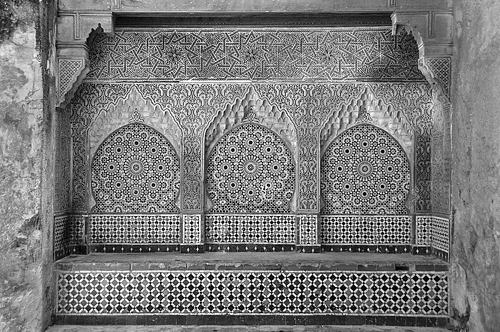
Matisse Route—The artist Matisse, who traveled to Tangier in 1912, was inspired by his wanderings through this area, picking up themes that show up in much of his art. The diamond-shaped stones embedded in the street (you’ll see them on the narrow lane leading up along the left side of the palace) mark a “Matisse Route” through the Kasbah, from the lower gate to the upper; those familiar with his works will recognize several scenes along this stretch.
Lined with lots of fishy eateries and entertaining nightclubs, this fine, wide, white-sand crescent beach (Plage de Corniche) stretches eastward from the port. The locals call it by the Spanish word playa. It’s packed with locals doing what people around the world do at the beach—with a few variations. Traditionally clad moms let their kids run wild. Along with lazy camels, you’ll see people—young and old—covered in hot sand to combat rheumatism. Early, late, and off-season, the beach becomes a popular venue for soccer teams. The palm-lined pedestrian street along the waterfront was renamed for King Mohammed VI, in appreciation for recent restorations. While the beach is cleaner than it once was, it still has more than its share of litter—great for a stroll, but maybe not for sunbathing or swimming. If you have a beach break in mind, do it on Spain’s Costa del Sol.

Just past the beach on the port side (between here and the Medina) is a zone of nondescript factories. Here local women sew clothing for big, mostly European companies that pay about $8 a day. Each morning and evening rush hour, the street is filled with these women commuters...on foot.
Most important: Be out in the Medina around 21:00. In the cool of the evening, the atmospheric squares and lanes become even more evocative. Then at about 22:00 things get dark, lonely, and foreboding.
El Minzah Hotel hosts traditional music most nights for those having dinner there (see “Eating in Tangier,” later; 85 Rue de la Liberté, tel. 0539-935-885).
The Cinema Rif, the landmark theater at the top of the Grand Socco, shows movies in French—which the younger generation is required to learn—and Arabic. The cinema is worth popping into, if only to see the Art Deco interior. As movies cost only 20 dh, consider dropping by to see a bit of whatever’s on...in Arabic (closed Mon, tel. 0539-934-683).
I’ve recommended two vastly different types of accommodations in Tangier: cozy Moroccan-style (but mostly French-run) guest houses in the maze of lanes of the Kasbah neighborhood, at the top of the Medina (old town); and big, modern international-style hotels in the urban-feeling new town, a 10-to-20-minute walk from the central sights.
Remember, if you want to call Tangier from Europe, dial 00 (Europe’s international access code), 212 (Morocco’s country code), then the local number (dropping the initial zero). June through mid-September is high season, when rooms may be a bit more expensive and reservations are wise. Most hotels charge an extra tax of 15-25 dh per person per night (typically not included in the prices I’ve listed here).
In Arabic, dar means “guest house.” You’ll find these in the Medina, or atmospheric old quarter. While the lower part of the Medina is dominated by market stalls and tourist traps, and can feel a bit seedy after dark, the upper part (called the Kasbah, for the castle that dominates this area) is more tranquil and feels very residential. All of these are buried in a labyrinth of lanes that can be very difficult to navigate; it’s essential to ask for very clear directions when you reserve. If you’re hiring a guide in Tangier, ask them to help you find your dar. (If you’re on your own, you can try asking directions when you arrive—but many local residents take that as an invitation to tag along and hound you for tips.) All of these are in traditional old houses, with rooms surrounding a courtyard atrium, and all have rooftop terraces where you can relax and enjoy sweeping views over Tangier. There are rarely stand-alone showers; instead, in Moroccan style, you’ll find a handheld shower in a corner of the bathroom.
$$$ Dar Chams Tanja, just below the lower Kasbah gate, has seven elegant, new-feeling rooms with all the comforts surrounding a clean-white inner courtyard with lots of keyhole windows. While pricey, it’s impeccably decorated, calm, and boasts incredible views from its rooftop terrace (five big Db-1,580 dh, two small Db-1,240 dh, sometimes discounts in slow times—check website, air-con, free Wi-Fi, hammam—Turkish-style bath, massage service, Rue Jnan Kabtan 2, tel. 0539-332-323, www.darchamstanja.com, darchamstanja@gmail.com).
$$$ La Maison Blanche (“The White House”), run by tour guide Aziz Begdouri, has nine rooms in a traditional Moroccan house with modern amenities in the Kasbah (Sb-1,000 dh, Db-1,100 dh, all with bathtubs, air-con, free Wi-Fi, just inside the upper gate of the Kasbah at Rue Ahmed Ben Ajiba 2, tel. 0539-373-545, www.lamaisonblanchetanger.com, info@lamaisonblanchetanger.com).
$$ La Tangerina, run by Jürgen (who’s German) and his Moroccan wife, Farida, has 10 comfortable rooms that look down into a shared atrium. At the top is a gorgeous rooftop seaview balcony (Db-600-935 dh in April and June-mid-Sept, otherwise Db-500-770; suite-1,520-1,650 dh in April and June-mid-Sept, otherwise 1,100-1,320 dh; prices depend on size and include tax, cash only, free Wi-Fi, wood-fired hammam, turn left as you enter the upper Kasbah gate and hug the town wall around to Riad Sultan 19, tel. 0539-947-731, www.latangerina.com, info@latangerina.com).
$$ Dar Nour, run with funky French style by Philippe, Jean-Olivier, and Catherine, has an “Escher-esque” floor plan that sprawls through five interconnected houses (it’s “labyrinthine like the Medina,” says Philippe). The 10 homey rooms feel very traditional, with lots of books and lounging areas spread throughout (Db-720 dh, junior suite Db-950 dh, suite Db-1,300 dh, cash only, free Wi-Fi in lobby, Rue Gourna 20, mobile 06-6211-2724, www.darnour.com, contactdarnour@yahoo.fr).
$$ Dar Sultan rents six romantically decorated rooms on a pleasant street in the heart of the Kasbah (Db-990 dh, larger Db-1,210 dh, Db with terrace-1,430 dh, free Wi-Fi in lobby and cable Internet in rooms, Rue Touila 49, tel. 0539-336-061, www.darsultan.com, dar-sultan@menara.ma).
These hotels are centrally located, near the TI, and within walking distance of the Grand Socco, Medina, and market. The first two are three-star hotels and take credit cards; the others are cash-only.
$$$ Rif & Spa Hotel, recently restored to its 1970s glamour, is a worthy splurge. Offering 127 plush, modern rooms, sprawling public spaces, a garden, a pool, and grand views, it feels like an oversized boutique hotel. The great Arabic lounge—named for Winston Churchill—with a harbor view compels you to relax (Sb-1,200 dh, Db-1,400 dh, 200 dh more July-Aug, 200 dh extra for sea view, see website for specials, breakfast-100 dh, air-con, elevator, free Wi-Fi in lobby, 3 restaurants, spa and sauna, Avenue Mohammed VI 152, tel. 0539-349-300, fax 0539-944-569, www.hotelsatlas.com, riftanger@menara.ma).
$$ Hotel Rembrandt feels just like the 1940s, with a restaurant, a bar, and a swimming pool surrounded by a great grassy garden. Its 70 rooms are outdated and simple, but clean and comfortable, and some come with views (Sb-450-550 dh, Db-550-710 dh, higher prices are for June-Aug, sea view-90 dh extra, includes tax, breakfast often included—otherwise 90 dh, air-con, elevator, free Wi-Fi, a 5-minute walk above the beach in a busy urban zone at Boulevard Mohammed VI 1, tel. 0539-937-870, fax 0539-930-443, www.hotel-rembrandt.com, reservations@hotel-rembrandt.com).
$$ Hotel Continental—actually in the Medina (at the bottom of the old town, facing the port)—is the Humphrey Bogart option, a grand old place sprawling along the old town. It has lavish, atmospheric, and recently renovated public spaces, a chandeliered breakfast room, and 55 spacious bedrooms with rough hardwood floors and new bathrooms. Jimmy, who’s always around and runs the shop adjacent to the lobby, says he offers everything but Viagra. When I said, “I’m from Seattle,” he said, “206.” Test him—he knows your area code (Sb-495 dh, Db-635 dh, about 100 dh more July-Sept, includes tax and breakfast, free Wi-Fi, Dar Baroud 36, tel. 0539-931-024, fax 0539-931-143, hcontinental @iam.net.ma). This hotel’s terrace aches with nostalgia. Back during the city’s glory days, a ferry connected Tangier and New York. American novelists would sit out on the terrace of Hotel Continental, never quite sure when their friends’ boat would arrive from across the sea...
$ Hotel El Djenina is a local-style business-class hotel—extremely plain, reliable, safe, and well-located. Its 40 rooms are a block off the harbor, midway between the port and the TI. Request a room on the back side to escape the street noise (Sb-319-357 dh, Db-382-463 dh, higher prices are for mid-May-Sept, cash only, no breakfast, no air-con, elevator, free Wi-Fi, tel. 0539-942-244, fax 0539-942-246, Rue al-Antaki 8, eldjenina@menara.ma).
$ Hotel Residencia Andalucía is solid, clean, and minimal. It’s buried in a totally non-touristy area in the new town, about a 20-minute walk from the Grand Socco. It has 19 rooms, a small reception, and a peaceful lobby (Sb-200-230 dh, Db-230-260 dh, higher prices are for mid-June-mid-Sept, cash only, Rue Omar Ben Abdelaziz 14, tel. 0539-941-334, Azdeen speaks a little English). Don’t confuse it with the similarly named but very exclusive Hotel Andalucía Golf across town.
Moroccan food is a joy to sample. First priority is a glass of the refreshing “Moroccan tea”—green tea that’s boiled and steeped once, then combined with fresh mint leaves to boil and steep some more, before being loaded up with sugar. Tourist-oriented restaurants have a predictable menu. For starters, you’ll find Moroccan vegetable soup (harira) or Moroccan salad (a combination of fresh and stewed vegetables). Main dishes include couscous (usually with chicken, potatoes, carrots, and other vegetables and spices); tagine (stewed meat served in a fancy dish with a cone-shaped top); and briouates (small savory pies). Everything comes with Morocco’s distinctive round, flat bread. For dessert, it’s pastries—typically, almond cookies.
I’ve mostly listed places in or near the Medina. (If you’d prefer the local equivalent of a yacht-club restaurant, survey the places along the beach.) Moroccan waiters expect about a 10 percent tip.
Le Saveur du Poisson is an excellent bet for the more adventurous, featuring one room cluttered with paintings adjoining a busy kitchen. There are no choices here. Just sit down and let owner Muhammad or his son, Hassan, take care of the rest. You get a rough hand-carved spoon and fork. Surrounded by lots of locals and unforgettable food, you’ll be treated to a multicourse menu. Savor the delicious fish dishes—Tangier is one of the few spots in Morocco where seafood is a major part of the diet. The fruit punch—a mix of seasonal fruits brewed overnight in a vat—simmers in the back room. Ask for an explanation, or even a look. The desserts are full of nuts and honey. The big sink in the room is for locals who prefer to eat with their fingers (200-dh fixed-price meal, Sat-Thu 12:00-16:00 & 19:00-22:00, closed Fri and during Ramadan; walk down Rue de la Liberté roughly a block toward the Grand Socco from El Minzah Hotel, look for the stairs leading down to the market stalls and go down until you see fish on the grill; Escalier Waller 2, tel. 0539-336-326).
Maison Communitaire des Femmes, a community center for women, hides an inexpensive, hearty lunch spot that’s open to everyone. A tasty three-course lunch is only 60 dh. Profits support the work of the center (Mon-Sat 12:00-16:00, last order at 15:30, also open 8:00-11:00 & 15:30-18:00 for cakes and tea, closed Sun, pleasant terrace out back, near slipper market just outside Grand Socco, Place du 9 Avril).
El Minzah Hotel offers a fancier yet still authentic experience. The atmosphere is classy but low-stress. It’s where unadventurous tourists and local elites dine. Dress up and choose between two dining zones: The white-tablecloth continental (French) dining area, called El Erz, is stuffy (80-150-dh starters, 120-240-dh main dishes); while in the Moroccan lounge, El Korsan, you’ll be serenaded by live traditional music (music nightly 20:00-23:30, belly-dance show at 20:30 and 22:30, no extra charge for music; 70-120-dh starters, 170-260-dh main dishes). There’s also a cozy wine bar here—a rarity in a Muslim country (50-120-dh starters, 120-190-dh main dishes, decorated with photos of visiting celebrities). At lunch, light meals and salads are served poolside (all dining areas open daily 13:00-16:00 & 20:00-22:30, Rue de la Liberté 85, tel. 0539-333-444, www.elminzah.com).
Le Salon Bleu has decent Moroccan food and some of the most spectacular seating in town: perched on a whitewashed terrace overlooking the square in front of the Kasbah Museum, with 360-degree views over the rooftops. Hike up the very tight spiral staircase to the top level, with the best views and lounge-a-while sofa seating. French-run (by the owners of Dar Nour guest house), it offers a simple menu of Moroccan fare—the 80-dh appetizer plate is a good sampler for lunch or to share for an afternoon snack. While there is some indoor seating, I’d skip this place if the weather’s not ideal for lingering on the terrace (30-40-dh starters, 80-120-dh main dishes, daily 10:00-22:00, Place de la Kasbah, mobile 06-6211-2724). You’ll see it from the square in front of the Kasbah; to reach it, go through the gate to the left (as you face it), then look right for the stairs up.
Le Fabrique has nothing to do with old Morocco. But if you want a break from couscous and keyhole arches, this industrial-mod brasserie with concrete floors and exposed brick has a menu of purely French classics—a good reminder that in the 20th century, Tangier was nearly as much a French city as a Moroccan one (50-140-dh starters, 120-250-dh main dishes, Tue-Sat 12:00-14:30 & 20:00-23:00, closed Sun-Mon, Rue d’Angleterre 7, tel. 0539-374-057). It’s a steep 10-minute walk up from the Grand Socco: Head up Rue d’Angleterre (left of Cinema Rif) and hike up the hill until the road levels out—it’s on your left.
Le Nabab is geared for tourists, but offers more style and less crass commercialism than the tourist traps listed below. Squirreled away in a mostly residential neighborhood just below the lower Kasbah gate (near the top of the Medina), it has a menu of predictable Moroccan favorites in a sleek concrete-and-white-tablecloths dining room with a few echoes of traditional Moroccan decor (170-dh three-course meal is a good deal to sample several items, 40-55-dh starters, 100-150-dh main dishes, Mon-Sat 12:00-15:30 & 19:30-23:30, closed Sun; below the lower Kasbah gate—bear left down the stairs, then right, and look for signs; Rue Al Kadiria 4, mobile 06-6128-4734).
Tangier seems to specialize in very touristy Moroccan restaurants that are designed to feed and entertain dozens or even hundreds of tour-group members with overpriced and predictable menus of Moroccan classics, and often live music and belly-dancing. The only locals you’ll see here are the waiters. For day-trippers who just want a safe, comfortable break in the heart of town, these restaurants’ predictability and Moroccan clichés are just perfect. For other travelers, these places are tour-group hell and make you thankful to be free. Each local guide has their own favorite, but these are the best-known.
Hamadi is as luxurious a restaurant as a tourist can find in Morocco, with good food at reasonable prices (25-40-dh starters, 60-80-dh main dishes, long hours daily, Rue Kasbah 2, tel. 0539-934-514).
Marhaba Palace has the most impressive interior, with huge keyhole arches ringing a grand upstairs hall slathered in colorful tilework. It also has the highest prices—hardly a good value. It’s near the upper gate to the Kasbah, so it’s convenient for a meal just before heading downhill through town to the Medina and market (170-240-dh fixed-price meals, daily 10:00-23:00, Rue Kasbah, tel. 0539-937-927).
Mamounia Palace, considered by most the bottom of the barrel, is right on the Petit Socco and more in the middle of the action. At least it has a Hollywood connection: The Moroccan teahouse scenes from the movie Inception were filmed on its upstairs balcony. A meal here will cost you about 100 dh for four courses (no à la carte, daily 11:00-22:00, tel. 0539-935-099).
In Tangier, all train traffic comes and goes from the suburban Gare Tanger Ville train station, one mile from the city center and a short Petit Taxi ride away (10-20 dh). If you’re traveling inland, check the information booth at the entrance of the train station for schedules (www.oncf.ma).
From Tangier by Train to: Rabat (8/day, 4-5 hours), Casablanca (station also called Casa Voyageurs, 7/day plus one night train, 5 hours; a new train line will cut the trip to about 2 hours by 2014), Marrakech (6/day, 9 hours, transfer in Casablanca), Fès (4/day, 4.5 hours).
Bus information is available at the sporadically functioning CMT bus company website (www.ctm.ma, tel. 0522-541-010).
From Tangier by Bus to: Ceuta and Tétouan (hourly, 1 hour).
From Fès to: Casablanca (12/day, 4.5 hours), Marrakech (4/day, 7 hours), Rabat (8/day, 4 hours), Meknès (10/day, 45 minutes), Tangier (6/day, 6 hours).
From Rabat to: Casablanca (2/hour, 45 minutes), Fès (5/day, 3 hours), Tétouan (5 buses/day, 4.5-6 hours, 4 trains/day, 6 hours).
From Casablanca to: Marrakech (9/day, 3.5 hours).
From Marrakech to: Meknès (2/day, 7 hours), Ouarzazate (6/day, 4 hours).
By Plane: Flights within Morocco are convenient and reasonable (about $180 one-way from Tangier to Casablanca).